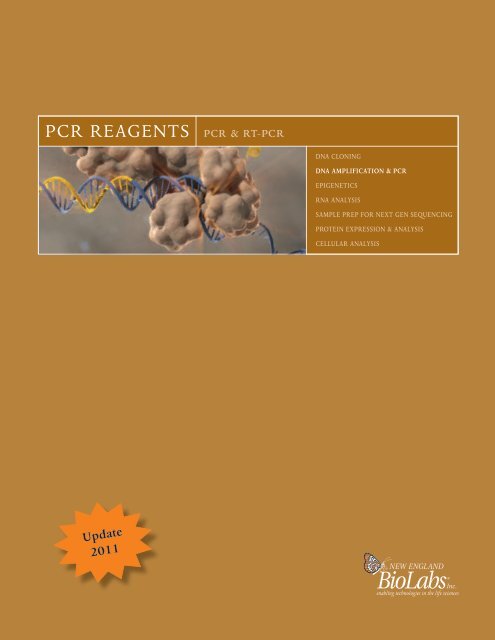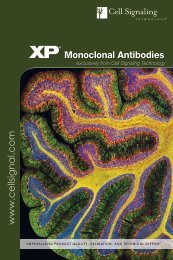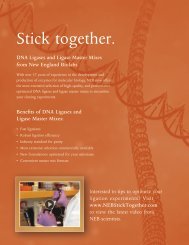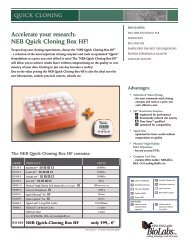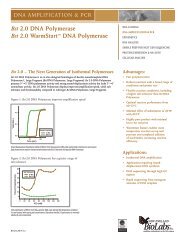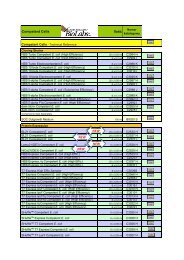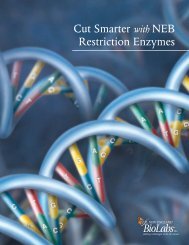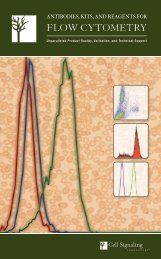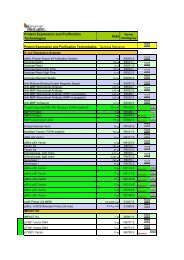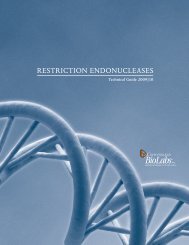yNEB105_PCR - 2012.pdf - Lab-JOT
yNEB105_PCR - 2012.pdf - Lab-JOT
yNEB105_PCR - 2012.pdf - Lab-JOT
- No tags were found...
You also want an ePaper? Increase the reach of your titles
YUMPU automatically turns print PDFs into web optimized ePapers that Google loves.
<strong>PCR</strong> REAGENTS <strong>PCR</strong> & RT-<strong>PCR</strong>dnA CloningDNA AMPLIFICATION & <strong>PCR</strong>EPIGENETICSRNA ANALYSISSAMPLE PREP FOR NEXT GEN SEQUENCINGProtein Expression & AnalysisCellular AnalysisUpdate2011
Pcr Reagents From NEBFor over 35 years, New England Biolabs, Inc. has been a world leaderin the discovery and production of reagents for the life science industry.NEB offers a wide range of DNA polymerases and through our commitmentto research, ensures the development of innovative, high qualitytools for <strong>PCR</strong>. Our product quality, enzyme expertise and outstandingtechnical support bring unparalled confidence to your <strong>PCR</strong> experiments.When choosing a polymerase for <strong>PCR</strong>, we recommend starting withOneTaq tm or Phusion ® DNA Polymerases (shown below in gold). Bothoffer robust amplification; OneTaq is ideal for a wide range of templates(routine, AT- and GC-rich) while Phusion provides maximum fidelity.DNA CloningDNA AMPLIFICATION & <strong>PCR</strong>EpigeneticsRNA ANALYSISSample Prep for next gen sequencingProtein Expression & AnalysisCellular Analysis<strong>PCR</strong> Polymerase Selection ChartPropertiesOneTaq OneTaq Hot Start Phusion ® * TaqLongAmp ®TaqCrimsonTaq®Vent RDeep®Vent RFidelity vs. Taq 2X 2X 50X 1X 2X 1X 5X 6X ND 1XAmplicon Size
troubleshooting<strong>PCR</strong> Troubleshooting GuideThe following guide can be used to troubleshoot <strong>PCR</strong> reactions. Additional tips for optimizingreactions can be found in the technical reference section of our website, www.neb.com.Problem Possible Cause SolutionSequenceerrorsIncorrectproductsizeNo productMultiple ornon-specificproductsLow fidelity polymeraseSuboptimal reaction conditionsUnbalanced nucleotide concentrationsTemplate DNA has been damagedDesired sequence may be toxic to hostIncorrect annealing temperatureMisprimingImproper Mg ++ concentrationNuclease contaminationIncorrect annealing temperaturePoor primer designPoor primer specificityInsufficient primer concentrationMissing reaction componentSuboptimal reaction conditionsPoor template qualityPresence of inhibitor in reactionInsufficient number of cyclesIncorrect thermocycler programmingInconsistent thermocycler block temperatureContamination of reaction tubesor solutionsComplex templatePremature replicationPrimer annealing temperature too lowIncorrect Mg ++ concentrationPoor primer designExcess primerContamination withexogenous DNA• Choose a higher fidelity polymerase such as Phusion ® ®(NEB #M0530)*, Vent R(NEB #M0254) orDeep Vent R(NEB #M0258) DNA Polymerases• Reduce number of cycles• Decrease extension time• Decrease Mg ++ concentration in the reaction• Prepare fresh deoxynucleotide mixes• Start with a fresh template• Try repairing DNA template with the PreCR Repair Mix (NEB #M0309)• Limit UV exposure time when analyzing or excising <strong>PCR</strong> product from the gel• Clone into a non-expression vector• Use a low-copy number cloning vector• Recalculate primer T mvalues using the NEB T mcalculator (www.neb.com/TmCalculator)• Verify that primers have no additional complementary regions within the template DNA• Adjust Mg ++ concentration in 0.2–1 mM increments• Repeat reactions using fresh solutions• Recalculate primer T mvalues using the NEB T mcalculator (www.neb.com/TmCalculator)• Test an annealing temperature gradient, starting at 5°C below the lower T mof the primer pair• Check specific product literature for recommended primer design• Verify that primers are non-complementary, both internally and to each other• Increase length of primer• Verify that oligos are complementary to proper target sequence• Primer concentration can range from 0.05–1 µM in the reaction. Please see specific product literature for ideal conditions• Repeat reaction setup• Optimize Mg ++ concentration by testing 0.2–1 mM increments• Thoroughly mix Mg ++ solution and buffer prior to adding to the reaction• Optimize annealing temperature by testing an annealing temperature gradient, starting at 5°C belowthe lower T mof the primer pair• Analyze DNA via gel electrophoresis before and after incubation with Mg ++• Check 260/280 ratio of DNA template• Further purify starting template by alcohol precipitation, drop dialysis or commercial clean up kit• Decrease sample volume• Rerun the reaction with more cycles• Check program, verify times and temperatures• Test calibration of heating block• Autoclave empty reaction tubes prior to use to eliminate biological inhibitors• Prepare fresh solutions or use new reagents• Use OneTaq DNA Polymerases• For GC-rich templates, use OneTaq DNA Polymerase (NEB #M0480) with OneTaq GC Reaction Buffer(plus OneTaq High GC Enhancer, if necessary) or Phusion ® DNA Polymerase* (NEB #M0530) with GC Buffer• For longer templates, we recommend LongAmp ® Taq DNA Polymerase• Use a hot start polymerase, such as OneTaq Hot Start DNA Polymerase (NEB #M0481)• Set up reactions on ice using chilled components and add samples to thermocycler preheated to thedenaturation temperature• Increase annealing temperature• Adjust Mg ++ in 0.2–1 mM increments• Check specific product literature for recommended primer design• Verify that primers are non-complementary, both internally and to each other• Increase length of primer• Avoid GC-rich 3´ ends• Primer concentration can range from 0.05–1 µM in the reaction. Please see specific product literature forideal conditions.• Use positive displacement pipettes or non-aerosol tips• Set-up dedicated work area and pipettor for reaction setup• Wear gloves during reaction setupIncorrect template concentration• For low complexity templates (i.e. plasmid, lambda, BAC DNA), use 1 pg–10 ng of DNA per 50 µl reaction• For higher complexity templates (i.e. genomic DNA), use 1 ng–1 µg of DNA per 50 µl reaction4* Phusion DNA Polymerase was developed by Finnzymes Oy, now a part of Thermo Fisher Scientific. This product is manufactured by New England Biolabs, Inc. underagreement with, and under the performance specifications of Thermo Fisher Scientific. Phusion ® is a registered trademark and property of Thermo Fisher Scientific.
phusion dna polymerase®PhusionHigh-Fidelity DNA PolymeraseThe unique Phusion ® High-Fidelity DNA Polymerase offers robust performance.Phusion DNA Polymerase generates products with accuracy and speed previouslyunattainable with a single enzyme, even on the most difficult templates. Its uniquestructure, a novel Pyrococcus-like enzyme fused with a processivity-enhancing domain,enhances fidelity, making Phusion DNA Polymerase a superior choice for cloning andsetting a new standard for <strong>PCR</strong> performance. With an error rate 50-fold lower thanthat of Taq DNA Polymerase and 6-fold lower than that of Pyrococcus furiosus DNAPolymerase, it is the most accurate thermostable polymerase available. Additionally,Phusion DNA Polymerase possesses processivity 10-fold greater than Pyrococcus furiosusDNA Polymerase and twice that of Taq DNA Polymerase.Phusion ® High-Fidelity DNA Polymerase ............................................................................... M0530S/LPhusion ® High-Fidelity <strong>PCR</strong> Kit ............................................................................................... E0553S/LPhusion ® High-Fidelity <strong>PCR</strong> Master Mix with HF Buffer .................................................... M0531S/LPhusion ® High-Fidelity <strong>PCR</strong> Master Mix with GC Buffer ................................................... M0532S/LAdvantages:• Extreme Fidelity - Highest of anycommercially available thermostablepolymerase (50X greater than Taq)• High Speed - Extension times aredramatically reduced (10X fasterthan Pfu)• Robust Reactions - Maximal successwith minimal optimization• High Yield - Increased product yieldwith minimal enzyme amountPhusion DNA Polymerase generates amplicons withhigh yield and much shorter extension timesPhusion from NEB High Fidelity Pfu Modified KOD(1 unit) (2.5 units) (1 unit)M 1 1.5 3.8 7.6 M 1 1.5 3.8 7.6 M 1 1.5 3.8 7.6 minCalculatorFor help with primer design,try our T mcalculator atwww.neb.com/TmCalculatorA 3.8 kb fragment was amplified from 50 ng of Jurkat gDNA using different polymerases.Reactions were carried out according to the manufacturer’s recommended conditions.Extension times are indicated (in minutes). Ladder M is a 1 kb DNA Ladder (NEB #N3232).Phusion Buffer Selection ChartChoice of Buffer Presence Of Detergent NEB #Phusion HF Bufferdefault buffer for high-fidelityamplificationPhusion GC Bufferfor long, difficult or GC-richtemplates (when HF buffer fails)Phusion HF Buffer PackDetergent-free Phusion HF Buffer PackPhusion GC Buffer PackDetergent-free Phusion GC Buffer PackB0518SB0520SB0519SB0521SPhusion ® DNA Polymerase was developedby Finnzymes Oy, now a part ofThermo Fisher Scientific. This product ismanufactured by New England Biolabs,Inc. under agreement with, and underthe performance specifications of ThermoFisher Scientific. Phusion ® is a registeredtrademark and property of Thermo FisherScientific.Please note that product numbershave changed, but pack sizes havestayed the same.Visit www.neb.com/phusionfor more information.www.neb.com 5
OneTaq dna polymerasesOneTaq DNA PolymeraseOneTaq Hot Start DNA PolymeraseAn optimized blend of Taq and Deep Vent R®DNA polymerases, OneTaq and OneTaqHot Start DNA Polymerases offer robust amplification across a wide range of templates.The 3´–5´ exonuclease activity of Deep Vent DNA Polymerase increases the fidelity androbustness of Taq and the hot-start formulation combines convenience with decreasedinterference from primer-dimers and secondary products. Additionally, OneTaq ReactionBuffers and High GC Enhancer have been formulated for robust yields with minimaloptimization, regardless of a template’s GC content.OneTaq DNA Polymerase is supplied with two 5X buffers (Standard and GC), as well asa High GC Enhancer solution. For most routine, AT- rich or complex amplicons with upto ~65% GC content, OneTaq Standard Reaction Buffer provides robust amplification.For GC-rich amplicons, the OneTaq GC Reaction Buffer can improve both performanceand yield. For particularly high GC (>65%) or difficult amplicons, the OneTaq High GCEnhancer can be added to reactions containing OneTaq GC Buffer. These formulationsensure maximum performance for routine, AT- or GC-rich amplicons.Advantages:• Exceptional Performance - Ideal fora wide range of templates, includingroutine, AT- and GC-rich• Robust - High yields with minimaloptimization• Convenience - Multiple productformats (stand-alone enzyme, mastermixes, and Quick-Load ® formats)• Hot Start - Allows room temperaturereaction setup and does not require aseparate activation step• Compatible - Suitable for standardTaq protocolsMaster Mix FormulationsIn addition to stand-alone enzymes, both OneTaq and OneTaq Hot Start DNAPolymerases are available in master mix and Quick-Load ® master mix formats. Mastermix formulations include dNTPs, MgCl 2and other buffers and stabilizers. The Quick-Load master mix formulations also include two tracking dyes for use with downstreamvisualization (i.e. agarose gels). With these convenient formats, the addition of primersand template are all that is required for robust amplification.Achieve robust amplification for routine,AT- and GC-rich templates with OneTaqAT-rich Standard GC-rich High GCkb M 29 37 47 55 65 66 73 79 %GC10.08.06.05.04.03.02.01.5OneTaq DNA Polymerase ................................................................................................... M0480S/L/XOneTaq 2X Master Mix with Standard Buffer ...................................................................... M0482S/LOneTaq 2X Master Mix with GC Buffer ............................................................................... M0483S/LOneTaq Quick-Load ® 2X Master Mix with Standard Buffer .............................................. M0486S/LOneTaq Quick-Load ® 2X Master Mix with GC Buffer ....................................................... M0487S/L1.00.5Standard Reaction BufferGC Reaction BufferPlus High GC EnhancerOneTaq Buffer RecommendationsAmplicon% GC BufferRecommended DefaultBuffer< 50% GC OneTaq Standard Reaction Buffer50–65% GC OneTaq Standard Reaction Buffer> 65% GC OneTaq GC Reaction BufferOptimizationNotesAdjust annealing temperature,primer/template concentration, etc.if needed.OneTaq GC Reaction Buffer canbe used to enhance performance ofdifficult amplicons.OneTaq GC Reaction Buffer with10-20% OneTaq High GC Enhancercan be used to enhance performanceof difficult amplicons.Amplification of a selection of sequences with varying AT and GCcontent from human and C. elegans genomic DNA using OneTaqDNA Polymerase. GC content is indicated above gel. Marker M isthe 1 kb DNA Ladder (NEB #N3232).6
OneTaq Hot Start DNA Polymerase allows roomtemperature reaction setup with no separate activation stepIn contrast to chemically modified or antibody-based hot start polymerases, NEB’s OneTaqHot Start utilizes aptamer technology. This unique modified oligonucelotide binds to thepolymerase through non-covalent interactions, blocking polymerase activity at temperaturesbelow 45°C. The polymerase is activated during normal cycling conditions, allowing reactionsto be set up at room temperature. OneTaq Hot Start DNA Polymerase does not requirea separate high temperature incubation step to activate the enzyme and can be used in typicalTaq-based cycling protocols. This ultimately shortens reaction times and increases ease of use.Additionally, the aptamer has been rigorously tested under a number of conditions and noeffect has been observed on processes such as ligation, reverse transcription, etc.OneTaq Hot Start DNA Polymerase .................................................................................. M0481S/L/XOneTaq Hot Start 2X Master Mix with Standard Buffer .................................................... M0484S/LOneTaq NEB OneTaq Hot Start DNA PolymeraseHot Start 2X Master Mix with GC Buffer .............................................................. M0485S/LOneTaq Hot Start Quick-Load ® 2X Master Mix with Standard Hot Start Competitor Buffer ............................ 1 M0488S/LOneTaq Hot Start Quick-Load ® Hot Start Competitor 32X Master Mix with GC Buffer ...................................... M0489S/LComparison of OneTaq Hot Start DNA Polymerase Hot to Start other Competitor commercially 6 + Competitor's available Enhancer hot for start GC rich polymerases.<strong>PCR</strong>ABYield (ng/µl) after 1:1 dilution % Purity of TargetYield (ng/µl) after 1:1 dilution10050654320NEB OneTaq Hot Start DNA Polymerase + 20% High GC EnhancerHot Start Competitor 3 + Competitor's Enhancer for GC rich <strong>PCR</strong>Hot Start Competitor 4Hot Start Competitor 5Hot Start Competitor 6Hot Start Competitor 7Control (55% GC) 66% 68% 68% 73% 79% 80%NEB OneTaq Hot Start DNA PolymeraseNEB OneTaq Hot Start DNA Polymerase+ 20% High GC EnhancerOther commercially availableHot Start productsOther commercially available Hot Startproducts with supplied enhancers10Control (55% GC) 66% 68% 68% 73% 79% 80%Reactions containing high GC human genomic DNA templates were set up at room temperature. <strong>PCR</strong> experiments included 30 cycles. Purity (A) and Yield (B) werecalculated via microfluidic analysis from triplicate reactions. OneTaq polymerases were used with GC Buffer. Some OneTaq reactions also contained High GC Enhancer(striped bars). Competitor polymerases were cycled according to manufacturer’s recommendations and included GC enhancers when supplied (striped bars).www.neb.com 7
Taq DNA PolymerasesTaq DNA PolymeraseTaq DNA Polymerase is the industry standard for routine <strong>PCR</strong>. When cost per reaction andyield are priorities, NEB provides high quality recombinant Taq at an exceptional value. Toaccommodate a variety of <strong>PCR</strong> applications, Taq is available with different reaction buffers.Standard Taq Buffer is designed to support existing <strong>PCR</strong> platforms and is an ideal choicefor DHPLC and high-throughput applications. ThermoPol Buffer is formulated to promotehigh product yields, even under demanding conditions.Taq DNA Polymerase with ThermoPol Buffer .................................................................. M0267S/L/XTaq DNA Polymerase with ThermoPol II (Mg-free) Buffer .................................................. M0321S/LTaq DNA Polymerase with Standard Taq Buffer ............................................................... M0273S/L/XTaq DNA Polymerase with Standard Taq (Mg-free) Buffer ................................................... M0320S/LTaq <strong>PCR</strong> Kit ....................................................................................................................................... E5000STaq <strong>PCR</strong> Kit with Controls ............................................................................................................. E5100STaq 5X Master Mix ..................................................................................................................... M0285S/LTaq 2X Master Mix ..................................................................................................................... M0270S/LQuick-Load Taq 2X Master Mix ............................................................................................ M0271S/LAdvantages:• Value - Industry standard for routine<strong>PCR</strong> at a low price• Convenience - Master mixes, bufferchoice, tracking dye and kits available• Choice - Reaction buffers accommodatea variety of <strong>PCR</strong> applications• Flexibility - Able to incorporatedUTP, dITP and fluorescently-labelednucleotidesTaq Buffer Selection ChartChoice of Buffer Mg-Control NEB #Standard Taq Reaction Buffer:Taq with Standard Taq BufferM0273S/LDetergent-free and designed to becompatible with existing assay systems Taq with Standard Taq (Mg-free) Buffer M0320S/LThermoPol Buffer:Designed to optimize yields and specificityCrimson Taq Reaction Buffer:Contains crimson tracking dye, allowingsamples to be loaded directly onto a gelTaq with ThermoPol BufferTaq with ThermoPol II (Mg-free) BufferCrimson TaqCrimson Taq with (Mg-free) BufferM0267S/LM0321S/LM0324S/LM0325S/LCrimson Taq delivers additional convenienceExperience the performance of Taq DNA Polymerase in a more convenient format.Ideal for both routine and high throughput applications, Crimson Taq Reaction Bufferis optimized for amplification and contains tracking dye that allows samples to be loadeddirectly onto a gel.Crimson Taq DNA PolymeraseCrimson Taq DNA Polymerase ................................................................................................. M0324S/LCrimson Taq DNA Polymerase with (Mg-free) Buffer ........................................................... M0325S/LAmplification with Crimson Taqkb— 10.0— 4.0— 2.0Crimson Taq DNA Polymerase offers the convenience ofloading samples directly onto a gel.— 1.00.6 1.2 1.5 2.8 4.0 5.0 MAmplicon Size (kb)— 0.5Amplification of specific sequences from humangenomic DNA using Crimson Taq DNA Polymerase.Amplicon sizes are indicated below gel. Marker Mis NEB 1 kb DNA Ladder (NEB #N3232).8
LongAmp ® Taq enables extension of longer ampliconsAn optimized blend of Taq and Deep Vent R®DNA Polymerases, LongAmp ® Taq DNAPolymerase enables amplification of up to 40 kb <strong>PCR</strong> products with a fidelity higher thanTaq DNA Polymerase alone. LongAmp Taq is also available with Crimson tracking dyein the reaction buffer.LongAmp ® Taq DNA Polymerase ............................................................................................. M0323S/LLongAmp ® Taq <strong>PCR</strong> Kit .................................................................................................................. E5200SLongAmp ® Taq 2X Master Mix ................................................................................................. M0287S/LCrimson LongAmp ® Taq DNA Polymerase ............................................................................. M0326S/LAmplification of longer templates with LongAmp Taq0.5 0.6 2 3 4 8 12 20 30 MAmplicon Size (kb)kb— 10.0— 4.0Multiplex <strong>PCR</strong> 5X Master Mix for multiple templatesMultiplex <strong>PCR</strong> can simultaneously detect two or more products in a single reaction.Multiplex <strong>PCR</strong> can also be used for semi-quantitative gene expression analysis usingcDNA templates. The NEB Multiplex <strong>PCR</strong> 5X Master Mix is an easy-to-use solutionfeaturing high quality recombinant Taq DNA Polymerase. The mix is optimized forhigh yield and performance. Its performance is illustrated below in a 15-plex <strong>PCR</strong>reaction using human genomic DNA. The 5X formulation allows maximal flexibilityfor input of custom primers and template DNAs.— 2.0— 1.0— 0.5Amplification of specific sequences from humangenomic DNA using LongAmp Taq DNA Polymerase.Amplicon sizes are indicated below gel. Marker Mis NEB 1 kb DNA Ladder (NEB #N3232).Tips for usingTaqDNA Polymerase:• Use 20 pg–20 ng/ml of plasmid or viraltemplates• Use 20 ng–20 µg/ml of genomictemplates• Generally, primers should be 20–30nucleotides in length, with an idealGC content of 40–60%• When engineering restriction sites into theend of primers, 4–6 extra bases should beadded between the restriction site and the5´ end of the primer• Final primer concentration should be0.1–0.5 µM each• Final Mg 2+ concentration shouldbe 1.5–2.0 mM• Typical dNTP concentration is200 µM each• Use 0.25–2.5 units of Taq/50 µl reaction• Initial denaturation at 95°C isrecommended• Typical annealing temperatures are 5°Cbelow the lowest T mof the primers, andare generally in the range of 55–60°C• Extension at 68°C is optimalMultiplex <strong>PCR</strong> 5X Master Mix ..................................................................................................... M0284S15-plex <strong>PCR</strong> reactionkb— 0.8— 0.7— 0.6— 0.5— 0.4For help with primer design,try our T mCalculator atwww.neb.com/TmCalculator— 0.3— 0.2100 ng 10 ng 1 ng M— 0.115-plex <strong>PCR</strong> using varying amounts of human genomicDNA. 1X Multiplex <strong>PCR</strong> 5X Master Mix was used with0.15 μM of each primer. The cycling conditions were 95°Cfor 1 minute, 35 cycles of 95°C for 20 seconds, 60°C for1 minute and 68°C for 2 minutes. Marker M is the 2-LogDNA Ladder (NEB #N3200).www.neb.com9
Vent/Deep VentVent R®DNA PolymeraseVent R®DNA Polymerase is a recombinant, high-fidelity thermophilic DNA polymerasewith the lowest cost per reaction of any high-fidelity <strong>PCR</strong> polymerase. It has an errorrate 5-fold lower than Taq DNA Polymerase, a characteristic derived in part from anintrinsic 3´→5´ proofreading exonuclease. In addition, greater than 90% of the polymeraseactivity remains following a 1 hour incubation at 95°C, ensuring maximal activity overthe course of the <strong>PCR</strong> reaction. For high-fidelity amplification of routine targets, Vent RDNA Polymerase offers exceptional value.Advantages:• High Fidelity - 5X greater than Taq• High Thermostability - Half-life of6.7 hrs. at 95°CVent R(exo-) DNA Polymerase has been genetically engineered to eliminate the 3´→5´proofreading exonuclease activity resulting in higher yield <strong>PCR</strong>.Vent R®DNA Polymerase ............................................................................................................ M0254S/LVent R®(exo-) DNA Polymerase ................................................................................................. M0257S/LDeep Vent R®DNA PolymeraseDeep Vent R®DNA Polymerase is a recombinant, high-fidelity DNA polymerase withunsurpassed thermostability. This feature makes Deep Vent Ran ideal choice for <strong>PCR</strong>amplification of DNA targets with a high degree of secondary structure, even in theabsence of additives. It has an error rate 6-fold lower than Taq DNA Polymerase, acharacteristic derived in part from an integral 3´→5´ proofreading exonuclease. DeepVent R’s combination of extreme thermostability and high-fidelity make it an excellentchoice for accurate <strong>PCR</strong> amplification of GC-rich sequences or templates with secondarystructures.Advantages:• High Fidelity - 6X greater than Taq• Extremely High Thermostability -Half-life of 23 hours at 95°C• Difficult Templates - Ideal for GC-richor looped sequencesDeep Vent R(exo-) DNA Polymerase has been genetically engineered to eliminate the3´→5´ proofreading exonuclease activity resulting in higher yield <strong>PCR</strong>.Deep Vent R®DNA Polymerase .................................................................................................. M0258S/LDeep Vent R®(exo-) DNA Polymerase ....................................................................................... M0259S/LAmplification with Vent and Deep Vent DNA PolymerasesAB0.7 1.1 2.0 MAmplicon Size (kb)0.7 1.1 2.0 MAmplicon Size (kb)Amplification of Jurkat Genomic DNA with Vent R(A)and Deep Vent R(B) DNA Polymerases. Amplicon sizes areindicated below gel. Marker M is the 1 kb DNA Ladder(NEB #N3232).10
HEMO KlenTaqHemo KlenTaqHemo KlenTaq is a truncated version of Taq DNA Polymerase that contains mutationsmaking it resistant to inhibitors present in whole blood. Hemo KlenTaq offers theversatility of Taq and can successfully amplify samples containing up to 20% wholeblood from human and mouse sources in a 50 µl reaction volume.Hemo KlenTaq ........................................................................................................................... M0332S/LAmplification from human whole blood with Hemo KlenTaqkb1.5 —1.0 —0.5 —0.3 —M 1 2 3 4 5 6Lane 1: 5% blood + Na-EDTA2: 5% blood + K-EDTA3: 5% blood + Na-Heparin4: 5% blood + Na-Citrate5: 1 mm 2 FTA Gutherie Card containingdried human blood6: 1 mm 2 FTA Card containing driedhuman blood (washed with 50 µl H2O)Advantages:• Fast - No need for DNA extraction priorto the reaction or sample centrifugationafter the reaction• Robust amplification• Versatile - Works well with mostcommon anticoagulants, includingheparin, citrate and EDTA• Dependable - Ideal for diagnostic <strong>PCR</strong>Percent blood present in sample and anticoagulant used are indicated in the legend. Ladder M is the 2-Log DNA Ladder (NEB #N3200).EpiMarkHot Start Taq DNA PolymeraseEpiMark Hot Start Taq DNA Polymerase is a mixture of Taq DNA Polymerase and atemperature sensitive, aptamer-based inhibitor. This inhibitor binds reversibly to theenzyme, inhibiting polymerase activity below 45°C, but releases the enzyme duringnormal <strong>PCR</strong> cycling conditions. With reaction buffer that has been optimized for AT-richtemplates, EpiMark Hot Start Taq is an excellent choice for bisulfite-treated DNA.EpiMark Hot Start Taq DNA Polymerase...............................................................................M0490S/LAdvantages:• Convenience - Room temperaturereaction assembly, with no activationstep required• Ease-of-use - Supplied reactionbuffer has been optimized for AT-richtemplates, and for amplification of 1 kbof bisulfite converted DNAReverse TranscriptionNEB offers several reagents for cDNA Synthesis for use in applications including q<strong>PCR</strong>and qRT-<strong>PCR</strong>. For your convenience, reagents are available as kits or standalone products.cDNA Synthesis Selection ChartProduct NEB # FeaturesProtoScript ® AMV First StrandcDNA Synthesis KitProtoScript ® M-MuLVFirst strand cDNA Synthesis KitAMV Reverse TranscriptaseE6550SE6300S/LM0277S/T/L• Convenient 2-tube mix• Generates cDNA at least 10 kb in length• AMV enables synthesis of difficult templates requiringhigher reaction temps• Convenient 2-tube mix• Generates cDNA at least 10 kb in length• Robust RT works for a variety of templates• Robust RT for a broad temperature range (37–50°C)• Can be used for template requiring higher reaction tempsM-MuLV Reverse Transcriptase M0253S/L • Robust RT for a variety of templateswww.neb.com 11
RT-<strong>PCR</strong>®ProtoscriptM-MuLV Taq RT-<strong>PCR</strong> KitProtoscript ® M-MuLV Taq RT-<strong>PCR</strong> Kit has been designed for the sensitive detectionof mRNAs in a two-step process using M-MuLV Reverse Transcriptase (RT) and Taq 2XMaster Mix. Protoscript M-MuLV Taq RT-<strong>PCR</strong> Kit is optimized for greater sensitivityand higher yield.Protoscript ® M-MuLV Taq RT-<strong>PCR</strong> Kit ........................................................................................ E6400SAmplification1 2 3 4 5Advantages:• Robust - Generate a broad rangeof RT-<strong>PCR</strong> products with high yield• Sensitivity - Detects transcripts as low as20 pg total RNA• Flexibility - Detection of multipletargets from one reactionAmplification of different regions of human guanine nucleotideexchange factor p532 (15,164 bp, GenBank accession numberU50078). Approximately 2 µg of human spleen total RNAwas reverse transcribed using d(T) 23VN. Reactions were set upwith and without M-MuLV Reverse Transcriptase (-RT Control).After 30 cycles of amplification using 1/20th of the cDNA product,5 µl was analyzed on a 1% agarose gel. Lane 1: 2-log DNA Ladder,Lane 2: -RT Control of 1.2 kb fragment, Lane 3: 1.2 kb fragmentapprox. 15 kb from 3´ end, Lane 4: -RT Control of 0.9 kbfragment, Lane 5: 0.9 kb fragment approx. 1.1 kb from 3´ end.®ProtoscriptAMV LongAmp®Taq RT-<strong>PCR</strong> KitThe ProtoScript ® AMV LongAmp ® Taq RT-<strong>PCR</strong> Kit combines two powerful mixes,AMV Enzyme Mix and LongAmp Taq 2X Master Mix for 2-step RT-<strong>PCR</strong> applications.The two mixes require minimal handling during reaction setup and yet offer consistentand robust RT-<strong>PCR</strong> reactions. AMV Enzyme Mix can carry out first strand cDNA synthesisreactions with a broader optimal reaction temperature from 37°C to 50°C. LongAmp Taq2X Master Mix offers consistent and robust amplification from more than 14 kb cDNAproducts. Primer d(T) 23VN is included for anchored priming at the polyA-tail region ofmessenger RNAs. Random Primer Mix is an optimized mix of hexamer and d(T) 23VNprimers, offering complete coverage of RNA templates.Advantages:• Robust - Semi-quantitative expressionanalysis of mRNAs by agarose gelelectrophoresis• High Yield - Suitable for a broad rangeof RT-<strong>PCR</strong> products• Convenience - Two mixes offer optimalresults with simple reaction setupProtoscript ® AMV LongAmp ® Taq RT-<strong>PCR</strong> Kit .......................................................................... E5300SRT-<strong>PCR</strong> Selection ChartALL PURPOSEMAXIMUMLENGTHDIFFICULTTEMPLATESPRODUCT FEATURES NEB #ProtoScript M-MuLV TaqRT-<strong>PCR</strong> KitProtoScript AMVLongAmp ® Taq RT-<strong>PCR</strong> Kit• RT-<strong>PCR</strong> up to 4 kb• Robust, Consistent• Convenience of Master Mixes• Tolerates higher incubationtemperatures during RT (> 42˚C)• RT-<strong>PCR</strong> at least 10 kb• Robust, Consistent• Convenience of Master MixesE6400S/LE5300S/L12
Treatment of DNA®PreCRRepair MixThe PreCR ® Repair Mix is a cocktail of enzymes formulated to repair damaged DNAin vitro prior to <strong>PCR</strong>. The repair pre-treatment can be applied to techniques such as wholegenome amplification, DNA sequencing and microarray analysis.The PreCR Repair Mix uses enzymes in a coordinated process that emulates base excisionrepair. The heart of the mix is a combination of polymerase and ligase activities. Theligase acts strongly on nicks, but has very low activity on blunt ends to minimize chimericgene formation. Added to this core are enzymes that recognize different DNA lesions.The PreCR Repair Mix can repair a wide range of damaged DNA, resulting fromexposure to heat, low pH, oxygen, and/or UV light. The lesions repaired by thePreCR Repair Mix do not include all possible damages. For example, it cannot repairDNA crosslinks, such as those that occur during exposure to formalin, nor can the mixeffectively repair highly fragmented DNA.PreCR Repair Mix .................................................................................................................... M0309S/LProven repair with the PreCR Repair Mixkb10 –3.0 –PreCR Treatment– + – + – + – + – + – +A: UV exposure (l DNA)B: heat treatment (l DNA)C: oxidation (plasmid)D: UV exposure (human genomic DNA)E: hydrolysis & UV exposure (l DNA)F: hydrolysis (l DNA)M: 2-Log DNA Ladder (NEB #N3200Advantages:• Specific - Treats damaged DNA withoutharming template• Versatile - Can be used in conjunctionwith any thermophilic polymerase• Convenient - <strong>PCR</strong> can be done directlyon repair reaction• Flexible - Suitable for <strong>PCR</strong>,microarrays and other DNAtechnologiesPreCR Can BeUsed to Repair:• Abasic sites• Nicks• Thymidine dimers• Blocked 3´ ends• Oxidized guanine• Oxidized pyrimidines1.0 –M A B C D E FThe gel shows trial amplifications from damaged DNA thatwas either not treated (-) or treated (+) with the PreCR RepairMix. Type of DNA damage is shown. Note: heat treated DNA isincubated at 99°C for 3 minutes. Marker M is the 2-Log DNALadder (NEB #N3200).• Deaminated cytosineExo-AnPExo-AnP is a genetically engineered bifunctional polypeptide that is capable of degradingssDNA and dNTPs to dNDPs, dNMPs and nucleosides. This enzyme is purified from arecombinant E. coli strain and is active in common <strong>PCR</strong> buffers. Treated samples are readyfor Sanger DNA sequencing, single nucleotide polymorphism (SNP) analysis, nested <strong>PCR</strong>or diagnostic analysis.Advantages:• Fast - Reaction is complete in15 minutes• Convenience - No purificationfollowing digestion is requiredExo-AnP ....................................................................................................................................... M0360S/Lwww.neb.com 13
DNA LaddersDNA LaddersDNA ladders from New England Biolabs take the guesswork out of your DNA sampleanalysis. Select the ladder to suit your experimental needs and let our sharp, evenly-spacedbands help you achieve accuracy in your analysis. For your convenience, supplementalloading dye is provided with all ladders. In addition, our most popular ladders are availablein a Quick-Load (contains blue dye to track migration) and a TriDye format (containsthree dyes).DNA Ladders from New England BiolabsAdvantages:• Stable at room temperature• Sharp uniform bands with easy-toidentifyreference bands• Can be used for sample quantitation• Exceptional value1 kb DNA Ladder*0.8% TAE agarose gel.NEB #N3232kb10.08.06.05.04.03.02.01.51.00.5100 bp DNA Ladder*1.3% TAE agarose gel.NEB #N3231bp1,5171,2001,000900800700600500/5174003002001002-Log DNA Ladder*1.0% TBE agarose gel.NEB #N3200kb10.08.06.05.04.03.02.01.51.21.00.90.80.70.60.50.40.30.20.150 bp DNA Ladder**1.8% TBE agarose gel.NEB #N3236bp1,35091676670065060055050045040035030025020015010050bp766500350300250200150100755025Low Molecular WeightDNA Ladder**1.8% TBE agarose gel.NEB #N3233Mass DNA Ladder1% TBE agarose gel.NEB #N3237kb10.06.04.03.02.01.00.5Reverse MassDNA Ladder0.8% TAE agarosegel. Mass values arefor 0.75 µg/lane.NEB #3240Skb10.06.04.03.02.01.00.5Fast DNA Ladder1.2% TBE agarose gel.NEB #N3238kb10.05.03.02.01.51.0.766.500.300.1500.050<strong>PCR</strong> Marker1.8% TBE agarose gel.NEB #N3234bp76650030015050* Available in Quick-Load and Tri-Dye formats** Available in Quick-Load format14
nucleotidesNucleotide SolutionsDeoxynucleotide Solution SetThe Deoxynucleotide Solution Set contains four separate 100 mM solutionsof ultrapure nucleotides (dATP, dCTP, dGTP, and dTTP).Deoxynucleotide Solution Set ........................................................................................................ N0446SDeoxynucleotide Solution MixThe Deoxynucleotide Solution Mix is an equimolar mixture of ultrapuredATP, dCTP, dGTP, and dTTP. Each nucleotide is present at a concentrationof 10 mM in the mixture for a total dNTP concentration of 40 mM.Deoxynucleotide Solution Mix .................................................................................................. N0447S/L7-deaza-dGTP*A useful additive for <strong>PCR</strong> of GC-rich templates; contains a 5 mM solutionof 7-deaza-dGPT as a dilithium salt.* licensed from Roche Diagnostics GmbH7-deaza-dGTP*.................................................................................................................................. N0445SAcyclonucleotide SetAcyclonucleotide Set contains four separate tubes of acyNTPs (acyATP,acyCTP, acyGTP and acyTTP).Acyclonucleotide Set ........................................................................................................................ N0460SdATP SolutionContains 0.25 ml of 100 mM ultrapure dATP.dATP Solution .................................................................................................................................. N0440SRibonucleotide Solution SetRibonucleotide Solution Set consists of four separate 100 mM solutionsof ATP, GTP, CTP and UTP.Ribonucleotide Solution Set ...................................................................................................... N0450S/LRibonucleotide Solution MixThe Ribonucleotide Solution Mix is an equimolar mixture of ribonucleotidetriphosphates (rATP, rCTP, rGTP and rUTP). Each is supplied at aconcentration of 80 mM for a total concentration of 320 mM.Ribonucleotide Solution Mix ..................................................................................................... N0466S/Lwww.neb.com 15
guidelinesGeneral Guidelines for <strong>PCR</strong> OptimizationNew England Biolabs offers a diverse group of DNA Polymerases for <strong>PCR</strong>-based applications. Specific recommendations for <strong>PCR</strong>optimization can be found in the product literature or on the individual product webpages. However, these general guidelines willhelp to ensure success using New England Biolabs’ <strong>PCR</strong> enzymes.Setup GuidelinesDNA Template• Use high quality, purified DNA templateswhenever possible. Please refer to specificproduct information for amplification fromunpurified DNA (i.e. colony <strong>PCR</strong> or direct<strong>PCR</strong>).• For low complexity templates (i.e. plasmid,lambda, BAC DNA), use 1 pg-10 ng ofDNA per 50 µl reaction• For higher complexity templates (i.e. genomicDNA), use 1 ng-1 µg of DNA per50 µl reaction• Higher DNA concentrations tend todecrease amplicon specificity, particularlywhen a high number of cycles are runPrimers• Primers should typically be 20–40nucleotides in length• Ideal primer content is 40–60% GC• Primer T mcalculation should be determinedwith NEB’s T mCalculator(www.neb.com/TmCalculator)• Annealing temperatures should be determinedaccording to specific enzyme recommendations.Please note that Phusion*annealing temperature recommendationsare unique.• Primer pairs should have T mvalues thatare within 5°C• Avoid secondary structure (i.e. hairpins)within each primer and potential dimerizationbetween the primers• Final concentration of each primer shouldbe 0.05–1 μM in the reaction. Please referto the more detailed recommendations foreach specific enzyme.• Higher primer concentrations may increasesecondary priming and create spuriousamplification products• When amplifying products > 20 kb in size,primers should be ≥ 24 nucleotides inlength with a GC content above 50% andmatched T mvalues above 60°C• When engineering restriction sites onto theend of primers, 6 nucleotides should beadded 5´ to the site• To help eliminate primer degradation andsubsequent non-specific product formation,use a hot-start enzyme (i.e. OneTaq HotStart DNA Polymerase)Magnesium Concentration• Optimal Mg ++ concentration is usually1.5–2.0 mM for most <strong>PCR</strong> polymerases• Most <strong>PCR</strong> buffers provided by NEBalready contain sufficient levels of Mg ++ at1X concentrations. Please refer to the specificproduct information for Mg ++ content.• NEB offers a varietly of Mg-free reactionbuffers to which supplemental Mg ++ canbe added for applications where completecontrol over Mg ++ concentration isrequired• Further optimization of Mg ++ concentrationcan be done in 0.2-1 mM increments,if necessary. For some specific applications,the enzyme may require as much as 6 mMMg ++ in the reaction.• Excess Mg ++ may lead to spuriousamplification• Insufficient Mg ++ concentrations maycause reaction failureDeoxynucleotides• Ideal dNTP concentration is typically 200μM of each, however, some enzymes mayrequire as much as 400 μM each. Pleaserefer to specific product literature for moredetailed recommendations.• Excess dNTPs can chelate Mg ++ andinhibit the polymerase• Lower dNTP concentration can increasefidelity, however, yield is often reduced• The presence of uracil in the primer, template,or deoxynucleotide mix will causereaction failure when using archaeal <strong>PCR</strong>polymerases. Use OneTaq or Taq DNAPolymerases for these applications.Enzyme Concentration• Optimal enzyme concentration in the reactionis specific to each polymerase. Pleasesee the product literature for specificrecommendations.• In general, excess enzyme can lead toamplification failure, particularly whenamplifying longer fragmentsStarting Reactions• Unless using a hot start enzyme (i.e. One-Taq Hot Start DNA Polymerase), assembleall reaction components on ice• Add the polymerase last, wheneverpossible• Transfer reactions to a thermocycler thathas been pre-heated to the denaturationtemperature. Please note that pre-heatingthe thermocycler is not necessary whenusing a hot start enzyme (i.e. OneTaq HotStart DNA Polymerase).16
For more information on polymeraseproperties and usage visit the technicalreference section at www.neb.com.Cycling GuidelinesDenaturation• Optimal denaturation temperature rangesfrom 94°–98°C and is specific to thepolymerase in the reaction. Please referto product information for recommendedconditions.• Avoid longer or higher temperature incubationsunless required due to high GCcontent of the template• For most <strong>PCR</strong> polymerases, denaturationof 5–30 seconds is recommended duringcycling• NEB’s aptamer-based hot start enzymes donot require additional denaturation steps toactivate the enzymesAnnealing• Primer T mvalues should be determinedusing the NEB T mCalculator(www.neb.com/TmCalculator)• For <strong>PCR</strong> polymerases other than Phusion ®High-Fidelity DNA Polymerase*, annealingtemperatures are usually set at 2°–5°Cbelow the lowest T mof the primer pair• When using Phusion High-FidelityDNA Polymerase*, annealing temperaturesshould be set at 0°–3°C above the lowestT mof the primer pair. Please refer tothe product literature for detailed recommendations.• Non-specific product formation can oftenbe avoided by optimizing the annealingtemperature or by switching to a hot startenzyme (i.e. OneTaq Hot Start DNA Polymerase)• Annealing temperatures can be optimizedby doing a temperature gradient <strong>PCR</strong>,starting at 5°C below the lowest T mof theprimer pair• Ideally, primer T mvalues should be lessthan the extension temperature. However, ifT mvalues are calculated to be greater thanthe extension temperature, a two-step <strong>PCR</strong>program (combining annealing and extensioninto one step) can be employed.Extension• Extension temperature recommendationsrange from 65°–72°C and are specific toeach <strong>PCR</strong> polymerase. Please refer to theproduct literature for specific recommendations.• Extension rates are specific to each <strong>PCR</strong>polymerase. In general, extension ratesrange from 15–60 seconds per kb. Pleaserefer to the recommendations for eachspecific product.• Longer than recommended extension timescan result in higher error rates, spuriousbanding patterns and/or reduction ofamplicon yields* Phusion DNA Polymerase was developed by Finnzymes Oy, now apart of Thermo Fisher Scientific. This product is manufactured by NewEngland Biolabs, Inc. under agreement with, and under the performancespecifications of Thermo Fisher Scientific. Phusion ® is a registeredtrademark and property of Thermo Fisher Scientific.www.neb.com 17
ordering information<strong>PCR</strong> PolymerasesProduct NEB # SIZECrimson LongAmp ® Taq DNA Polymerase M0326S/L 250/1,250 unitsCrimson Taq DNA Polymerase M0324S/L 200/1,000 unitsCrimson Taq DNA Polymerase with (Mg-free) Buffer M0325S/L 200/1,000 unitsDeep Vent RDNA Polymerase M0258S/L 200/1,000 unitsDeep Vent R(exo-) DNA Polymerase M0259S/L 200/1,000 unitsEpiMark Hot Start Taq DNA Polymerase M0490S/L 100/500 rxnsHemo KlenTaq DNA Polymerase M0332S/L 200/1,000 rxns (25 µl rxn vol)LongAmp ® Taq 2X Master Mix M0287S/L 100/500 rxns (50 µl rxn vol)LongAmp ® Taq DNA Polymerase M0323S/L 500/2,500 unitsLongAmp ® Taq <strong>PCR</strong> Kit E5200S 100 rxns (50 µl rxn vol)Multiplex <strong>PCR</strong> 5X Master Mix M0284S 100 rxns (50 µl rxn vol)OneTaq DNA Polymerase M0480S/L/X 200/1,000/5,000 unitsOneTaq 2X Master Mix with Standard Buffer M0482S/L 100/500 rxns (50 µl rxn vol)OneTaq 2X Master Mix with GC Buffer M0483S/L 100/500 rxns (50 µl rxn vol)OneTaq Quick-Load ® 2X Master Mix with Standard Buffer M0486S/L 100/500 rxns (50 µl rxn vol)OneTaq Quick-Load ® 2X Master Mix with GC Buffer M0487S/L 100/500 rxns (50 µl rxn vol)OneTaq Hot Start DNA Polymerase M0481S/L/X 200/1,000/5,000 unitsOneTaq Hot Start 2X Master Mix with Standard Buffer M0484S/L 100/500 rxns (50 µl rxn vol)OneTaq Hot Start 2X Master Mix with GC Buffer M0485S/L 100/500 rxns (50 µl rxn vol)OneTaq Hot Start Quick-Load ® 2X Master Mix with Standard Buffer M0488S/L 100/500 rxns (50 µl rxn vol)OneTaq Hot Start Quick-Load ® 2X Master Mix with GC Buffer M0489S/L 100/500 rxns (50 µl rxn vol)Phusion ® High-Fidelity DNA Polymerase M0530S/L 100/500 unitsPhusion ® High-Fidelity <strong>PCR</strong> Kit E0553S/L 50/200 rxns (50 µl rxn vol)Phusion ® High-Fidelity <strong>PCR</strong> Master Mix with HF Buffer M0531S/L 100/500 rxns (50 µl rxn vol)Phusion ® High-Fidelity <strong>PCR</strong> Master Mix with GC Buffer M0532S/L 100/500 rxns (50 µl rxn vol)QuickLoad Taq 2X Master Mix M0271S/L 100/500 rxns (50 µl rxn vol)Taq 2X Master Mix M0270S/L 100/500 rxns (50 µl rxn vol)Taq 5X Master Mix M0285S/L 100/500 rxns (50 µl rxn vol)Taq DNA Polymerase with Standard Taq Buffer M0273S/L/X 400/2,000/4,000 unitsTaq DNA Polymerase with Standard Taq (Mg-free) Buffer M0320S/L 400/2,000 unitsTaq DNA Polymerase with ThermoPol Buffer M0267S/L/X 400/2,000/4,000 unitsTaq DNA Polymerase with ThermoPol II (Mg-free) Buffer M0321S/L 400/2,000 unitsTaq <strong>PCR</strong> Kit E5000S 200 rxns (50 µl rxn vol)®Vent RDNA Polymerase M0254S/L 200/1,000 units®Vent R(exo-) DNA Polymerase M0257S/L 200/1,000 unitscDNA Synthesis & RT-<strong>PCR</strong>ProtoScript ® AMV First Strand cDNA Synthesis Kit E6550S 30 rxnsProtoScript ® M-MuLV First Strand cDNA Synthesis Kit E6300S/L 30/150 rxnsProtoScript ® AMV LongAmp ® Taq RT-<strong>PCR</strong> Kit E5300S 30 rxnsProtoScript ® M-MuLV Taq RT-<strong>PCR</strong> Kit E6400S 30 rxnsM-MuLV Reverse Transcriptase M0253S/L 10,000/50,000 unitsAMV Reverse TranscriptaseM0277S/L/T200/1,000/500 unitsS/L (10,000 units/ml) – T (25,000 units/ml)18For full licensing information, please visit www.neb.com.
Treatment of DNAProduct NEB # SIZEPreCR ® Repair Mix M0309S/L 30/150 rxnsExo-AnP M0360S/L 100/500 rxnsCompanion Products1 kb DNA Ladder N3232S/L 200/1,000 gel lanes100 bp DNA Ladder N3231S/L 100/500 gel lanes2-Log DNA Ladder (0.1–10.0 kb) N3200S/L 100–200 / 500–1,000 gel lanes50 bp DNA Ladder N3236S/L 100–200 / 500–1,000 gel lanesLow Molecular Weight DNA Ladder N3233S/L 100/500 gel lanesFast DNA Ladder N3238S 50/200 gel lanesMass DNA Ladder N3237S 50/200 gel lanesReverse Mass Ladder N3240S 50/200 gel lanes<strong>PCR</strong> Marker N3234S 100/500 gel lanesDeoxynucleotide Solution Set N0446S 25 µmol of eachDeoxynucleotide Solution Mix N0447S/L 8 µmol of each/40 µmol of eachdATP Solution N0440S 25 µmolAcyclonucleotide Set N0460S 0.5 µmol of each7-deaza-dGTP N0445S 0.15 µmolRibonucleotide Solution Set N0450S/L 10 µmol of each/50 µmol of eachRibonucleotide Solution Mix N0466S/L 8 µmol of each/40 µmol of each<strong>PCR</strong> Polymerase Selection ToolNEB offers a wide range of <strong>PCR</strong> polymerases in several formats for specific research applications, various template lengthsand particular buffer requirements. Our <strong>PCR</strong> Polymerase Selection Tool shows all possible choices and recommends anoptimal DNA Polymerase for your experiment based on application and priority.Visit confident<strong>PCR</strong>.com to find theideal polymerase for your application.www.neb.com 19
GermanyNew England Biolabs GmbHFree Call: 0800/246 5227info@de.neb.comFranceNew England Biolabs FranceFree Call: 0800/100 632info@fr.neb.comNew England Biolabs, Inc.240 County RoadIpswich, MA 01938-2723USAUnited KingdomNew England Biolabs (UK), Ltd.Free Call: 0800 318486info@uk.neb.comBeNeLux:BIOKÉTel: +31(0)71 568 1000Tel: Belgium: 0800 71640info@bioke.comwww.bioke.comCZECH REPUBLIC:BIOTECH a.s.Tel: (Toll Free) 0800 124683biotech@biotech.czwww.biotech.czDENMARK:MEDINOVA SCIENTIFIC A/STel: (39) 56 20 00medinova@medinova.dkwww.medinova.dkFINLAND:FISHER SCIENTIFICRatastie 201620 VantaaTel: +358 9 329 100fisher.fi@thermofisher.comwww.fishersci.fiGREECE:BIOLINE SCIENTIFICTel: 210 5226547Fax: 210 5244744demagos@hol.grHUNGARY:Kvalitex ScientificTel: (1) 340-4700info@kvalitex.huwww.kvalitex.huISRAEL:Ornat Biochemicals and <strong>Lab</strong>oratoryEquipment Ltd.Tel: +972-8-9477077Fax: +972-8-9363934ornatbio@ornat.co.ilwww.ornat.co.ilITALY:EuroClone S.P.A.Free call: 800-315911info@euroclone.itwww.euroclonegroup.it/celbio/Jordan:BurjouanEst. for Medical & <strong>Lab</strong> Suppliestel: +962-6-5350949ahmad-m@burjouan.comwww.burjouan.comPOLAND:LENCOMM TRADE INTERNATIONALtel: (+48 22) 835-62-78office@lencomm.plwww.lencomm.pl<strong>Lab</strong>-<strong>JOT</strong> Tomasz Dzieczewskitel.: (+48 22) 758 59 07labjot@gmail.comwww.labjot.comSWEDEN:IN VITRO SWEDEN ABTel: (08) 30 60 10iv@invitro.sewww.invitro.seSPAIN/PORTUGAL:IZASA S.A.Tel: 902.20.30.70consultasbiotec@izasa.eswww.izasa.comSWITZERLAND:BIOCONCEPTTel: (061) 486 80 80info@bioconcept.chwww.bioconcept.chTURKEY:Sacem Life TechTel: +90/312/223 52 72sacem@sacem.com.trwww.sacem.com.trwww.neb.com<strong>PCR</strong>Version 3.0


